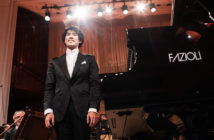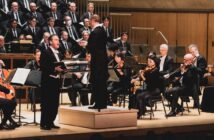There was no vice-regal musical salute Friday from the Orchestre Métropolitain, nor an “all rise” ceremony in the Maison symphonique. But Yannick Nézet-Séguin did draw attention to the presence in the Choeur Métropolitain of Governor General Julie Payette, who was stationed with the sopranos, as she had been the night before in a performance at the National Arts Centre in Ottawa. Imagine. The Queen’s representative as head of state singing with the multitudes. Great country, Canada.
Pretty good concert, too, concluding with Mozart’s Great Mass in C Minor, a comparably accomplished if less intensely dramatic piece than the Requiem. YNS brought his habitual sense of ebb and flow to the score. The muscular Credo (despite its fragmentary state) resolved naturally into the florid writing of the Et incarnatus est, the latter deftly handled by the sweet-toned British soprano Carolyn Sampson, with an array of assists form the OM woodwinds.
The Canadian mezzo-soprano Julie Boulianne was dark and lyrical while the American tenor Jonas Hacker and the Canadian bass-baritone Philippe Sly were firm in their supporting roles. The orchestra, on the large side and in no way attempting to imitate a “period” band, played well. Rather than tooting apologetically, the organ made a big sound in the Qui tollis. But the glory of the performance was the sturdy and mobile chorus of about 120, impressive in the big shouts of the Sanctus, athletic in the fugal writing of the Cum sancto spiritu. Credit François A. Ouimet and Pierre Tourville with the preparation.
The first half of the concert – and at 46 minutes, “half” is not far off – comprised the Fifth Symphony of Jacques Hétu, who died on Feb. 9, 2010, a few weeks before the premiere of the work by the Toronto Symphony Orchestra under Peter Oundjian. My original review of this ambitious score based on the wartime occupation and liberation of France was a split decision – in favour of the uneasy merriment of Prologue and the apotheosis of the choral finale, skeptical of the middle movements, titled L’Invasion and L’Occupation.
War obviously invites heavy percussion and dissonant brass as a means of illustration. One might argue that there could hardly be too much when the subject is the most destructive conflict of all time. But can there be too much for musical purposes? This is the question I continue to ask myself about a pair of movements that seem both too raucous and too much alike.
In the finale, a setting of “Liberté,” the Paul Éluard poem that was scattered over France in 1942 by the Royal Air Force, Hétu responds with real imagination to the poetry, in which strophic repetition (notably of the line “J’écris ton nom”) provides both a natural formal framework and the need to cultivate variety within it. The build-up was exciting and the big cadence on “Liberté” had a cathartic effect. YNS and his charges responded in kind. Would Hétu authorize a performance of the finale as a freestanding cantata?
The concert was dedicated to the memory of bassoonist René Bernard, founding member of the OM.














